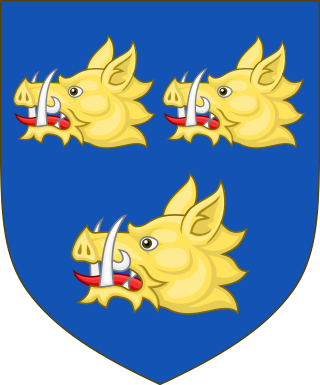
Marquess of Aberdeen and Temair, in the County of Aberdeen, in the County of Meath and in the County of Argyll, is a title in the Peerage of the United Kingdom. It was created on 4 January 1916 for John Hamilton-Gordon, 7th Earl of Aberdeen.

Earl of Sutherland is a title in the Peerage of Scotland. It was created circa 1230 for William de Moravia and is the premier earldom in the Peerage of Scotland. The earl or countess of Sutherland is also the chief of Clan Sutherland.
Cromartyshire was a county constituency of the House of Commons of Great Britain from 1708 until 1800, and of the House of Commons of the United Kingdom from 1801 to 1832.
William Gordon may refer to:

Three baronetcies have been created in the Baronetage of England for members of the Littleton or Lyttelton family. All three lines are descended from Thomas de Littleton, a noted 15th-century jurist. Despite differences in the spelling of the title, the names of all three lines were spelt in many varied ways in the early modern period, without distinction between the different branches of the family. This can be confusing, as the range of forenames in use was very limited.

The Chaytor family is an English gentry family on which has been conferred two baronetcies, one in the Baronetage of England and one in the Baronetage of the United Kingdom and several knighthoods. As of 2008 one baronetcy is extinct.
The Bannerman Baronetcy, of Elsick in the County of Kincardine, is a title in the Baronetage of Nova Scotia. It was created on 28 December 1682 for Alexander Bannerman. The eleventh Baronet was a pioneer military aviator. The twelfth Baronet was a soldier and courtier.
There have been six baronetcies created for persons with the surname Thomas, three in the Baronetage of England, one in the Baronetage of Great Britain and two in the Baronetage of the United Kingdom. Two of the creations are extant as of 2016.

The Hales Baronetcy, is a title in the Baronetage of England. There were three Hales baronetcies. The oldest was created in 1611 for Edward Hales. He was a member of a Kent family. The second was created in 1660 for Robert Hales, MP for Hythe 1659, also of a Kent family. The third was created in 1660 for John Hales of Coventry, co. Warwick.
There have been three baronetcies created for persons with the surname Foulis, one in the Baronetage of England and two in the Baronetage of Nova Scotia.
Sir Richard Butler, 5th Baronet was an Irish politician and baronet.
Sir James Fergusson of Kilkerran, 2nd Baronet, Lord Kilkerran (1688–1759) was a Scottish judge.
Robert Bruce Aeneas Macleod, 3rd Macleod of Cadboll, was Lord Lieutenant of Cromarty from 1794 until 1833, and, a staunch Tory, he sat as the Member of Parliament (M.P.) for Cromartyshire from 1807 to 1812.

Sir Abraham Elton, 2nd Baronet of Bristol and Clevedon Court, Somerset, was a British merchant, slave trader and Whig politician, who sat in the House of Commons for Taunton between 1724 and 1727, and then for Bristol from 1727 until his death in 1742. He also served as the High Sheriff of Bristol from 1710 to 1711, and was Mayor of Bristol for the year 1719 to 1720.

Sir William Gordon, 1st Baronet was a Scottish politician who sat in the House of Commons between 1708 and 1742.
Sir George Mackenzie, 4th Baronet, of Cromarty and Grandvale, was a Scottish politician who sat in the British House of Commons from 1729 to 1734.

The Mackenzie Baronetcy, of Tarbat in the County of Ross, was created in the Baronetage of Nova Scotia on 21 May 1628 for John Mackenzie. His son, the 2nd Baronet, was created Earl of Cromarty in 1703; he resigned the baronetcy in favour of his younger son Kenneth, who was created a baronet in the Baronetage of Nova Scotia on 29 April 1704, with remainder to his heirs male whatsoever and with the precedence of 1628. The 3rd Baronet was one of the Scottish representatives to the 1st Parliament of Great Britain and later represented Cromartyshire. The 4th Baronet was Member of Parliament for Cromartyshire. In 1744 he succeeded to the Mackenzie baronetcy of Roystoun on the death of his uncle Sir James Mackenzie, 1st Baronet, of Roystoun.

The Johnson baronetcy, of New York in North America, was created in the Baronetage of Great Britain on 27 November 1755 for the soldier William Johnson. The baronetcy was awarded for his victories at Crown Point and the Battle of Lake George earlier that year. His birth surname was MacShane, of which Johnson is a translation.

The Gordon baronetcy of Gordonstoun was created on 28 May 1625 in the Baronetage of Nova Scotia for Robert Gordon of Gordonstoun, fourth son of Alexander Gordon, 12th Earl of Sutherland. It was until 1908 the premier baronetcy in Scotland.

The Gordon baronetcy of Embo, Sutherland was created on 18 June 1631 for John Gordon, son of John Gordon who was a large landowner in the county.











